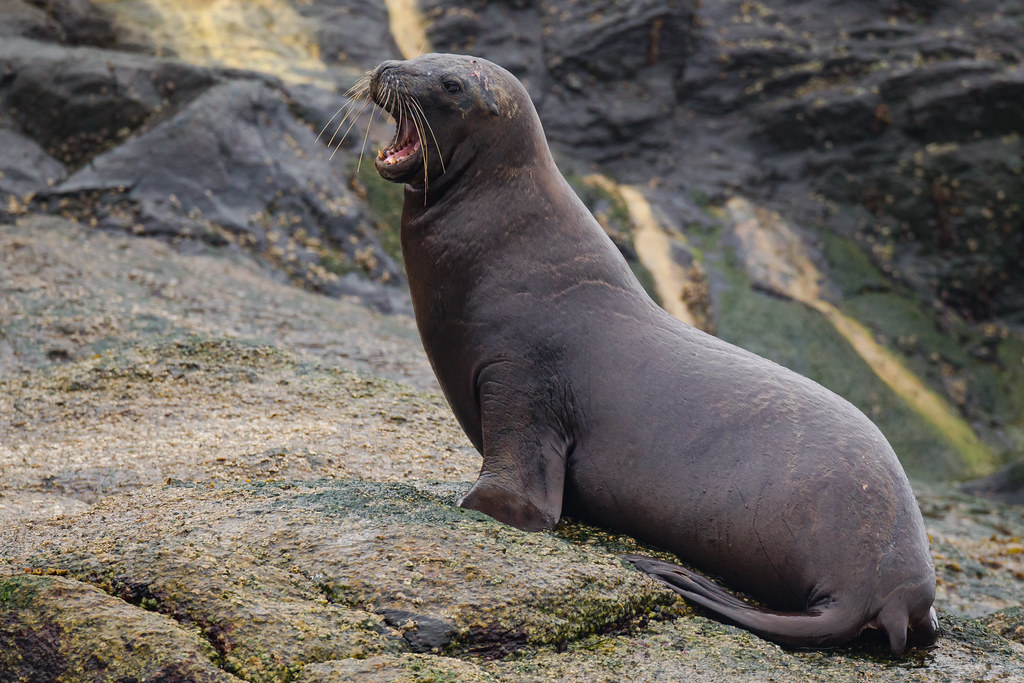
Picture this: a bustling colony sprawled across a rocky headland, the air filled with a chorus of roars and barks, and powerful, whiskered faces peering out from the waves. This is the vibrant world of the South American Sea Lion (Otaria flavescens), one of the most widespread and recognizable pinnipeds inhabiting the diverse coastlines of South America.
Often referred to as the Southern Sea Lion or Patagonian Sea Lion, these magnificent creatures are a common sight from the warm waters of Peru, down the vast coastlines of Chile and Argentina, and even around the Falkland Islands (Malvinas). They are a cornerstone of the marine ecosystem in this region and a true delight for wildlife enthusiasts.
A Distinctive Look: The “Lion” in Sea Lion
The name “sea lion” is particularly apt for this species, especially for the males. Adult male South American Sea Lions develop a thick, reddish-brown mane around their necks and shoulders, giving them a decidedly lion-like appearance. This mane, combined with their large heads and broad snouts, makes them quite distinct from other sea lion species. Males are significantly larger than females, reaching lengths of up to 8.5 feet and weighing over 700 pounds, while females are more slender, typically around 6.5 feet long and weighing up to 330 pounds.
Their fur color can vary, but generally, adults are a yellowish-brown to dark brown, often appearing darker when wet. Pups, however, are born with a darker, almost black coat, which gradually lightens as they mature.
Coastal Dwellers and Social Brawlers
South American Sea Lions are highly social animals, forming large, often noisy, colonies on sandy or rocky beaches, cliffs, and offshore islands. These “haul-out” sites are crucial for resting, molting, and, most importantly, breeding.
During the breeding season (typically from December to February), the colonies become a hive of activity. Dominant males establish territories, fiercely defending them against rivals through impressive displays of roaring, posturing, and sometimes dramatic fights. Females give birth to a single pup and will often mate again shortly after. The bond between mother and pup is strong, with mothers vocalizing to find their offspring amidst the clamor of the colony. Pups are nursed for several months and gradually begin to explore the water.
In the water, they are agile and efficient hunters, preying on a variety of fish, squid, octopus, and crustaceans. Their streamlined bodies and powerful flippers allow them to pursue their prey with ease.
Where to Experience Their World
If you’re planning a trip to South America’s coasts, there are numerous incredible opportunities to observe these captivating animals:
- Argentina: The Valdes Peninsula in Patagonia is world-renowned for its vast sea lion colonies, particularly Punta Pirámides and Punta Loma.
- Chile: Coastal areas and islands throughout the country, including the Humboldt Penguin National Reserve.
- Peru: The Ballestas Islands (Islas Ballestas) near Paracas are often called the “poor man’s Galapagos” and are teeming with South American Sea Lions, alongside various bird species.
- Uruguay: Cabo Polonio is home to one of the largest colonies in the country.
- Falkland Islands (Malvinas): Numerous islands host thriving populations.
When observing them, always remember to maintain a respectful distance and never disturb their natural behavior.
A Resilient Species Facing Modern Challenges
Currently, the South American Sea Lion population is generally considered stable and is listed as “Least Concern” by the IUCN. This is a positive sign, especially compared to some other sea lion species.
However, they are not without their challenges:
- Fisheries Interaction: Accidental entanglement in fishing gear is a significant threat.
- Human Disturbance: Growing tourism and coastal development can disrupt their vital haul-out and breeding sites.
- Pollution: Marine debris and pollutants can impact their health and environment.
- Climate Change: Potential shifts in prey distribution due to changing ocean temperatures.
The South American Sea Lion stands as a testament to the rich marine biodiversity of the southern hemisphere. Their boisterous colonies and impressive presence are a vital part of the coastal landscape, reminding us of the wild beauty that thrives along our oceans. Let’s continue to appreciate and protect these charismatic “kings” of the southern coasts!
Keep exploring:
- A Deep Dive into the Wonderful World of Sea Lions
- Sea Lions vs Seals: Unraveling the Mystery of Pinnipeds
More photos below ↓





Disclaimer: This blog post is for edutainment purposes only and may not be entirely accurate.






